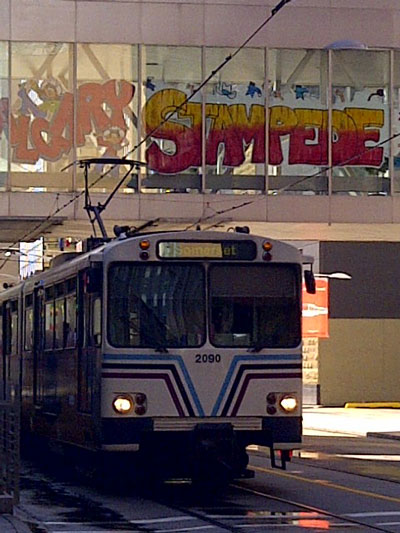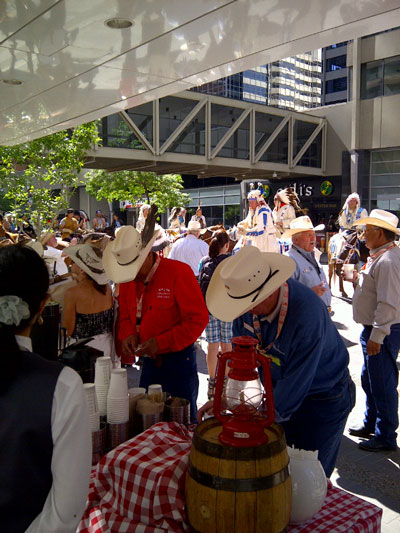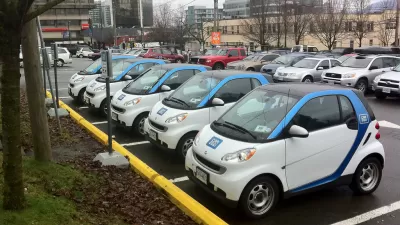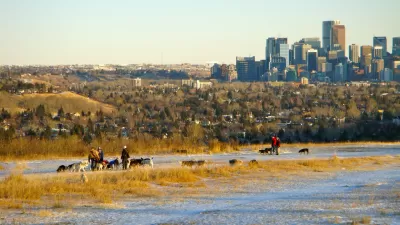Returning home to Vancouver last week after taking in some of the 100th Anniversary world-famous Calgary Stampede, I find myself thinking about the relationship between city-defining events and place-making. I also couldn’t help remembering an unusual moment in my career that relates to the Stampede. In 2006 when I was 36, after 4 rounds of interviews, I found myself in a closed-door session with Vancouver's City Council. I was being recommended to Council to become the new Director of City Planning, replacing former Co-Directors Larry Beasley and Dr. Ann McAfee. Council was meeting me for the first time, before going in-camera to officially decide on my hiring.
Returning home to Vancouver last week after taking in some of the 100th Anniversary world-famous Calgary Stampede, I find myself thinking about the relationship between city-defining events and place-making. I also couldn't help remembering an unusual moment in my career that relates to the Stampede.
In 2006 when I was 36, after 4 rounds of interviews, I found myself in a closed-door session with Vancouver's City Council. I was being recommended to Council to become the new Director of City Planning, replacing former Co-Directors Larry Beasley and Dr. Ann McAfee. Council was meeting me for the first time, before going in-camera to officially decide on my hiring.
Amongst the many city-building and leadership questions they peppered me with that day, one was definitely different. One Councilor, who I would later find out was a strong animal rights supporter, cast a critical eye at me, and asked pointedly what I thought of the Calgary Stampede!

At the time I was Calgary's Manager of Centre City Planning + Design. My successful work as a change-agent in Calgary had caught the attention of Beasley and other national urbanists, and was a big reason why I was being recommended to succeed Larry and Ann. But in this moment, this Councillor didn't want to ask about urban change or progressive planning. She was asking my opinion of the Stampede itself - and I could tell by the look in her eye, and the smiles and quiet laughter from other Councillors, that although the mood was light-hearted, her question was a mischievous trap. I knew there would definitely be a right and wrong answer in her mind.
The then-City Manager quickly intervened to rescue me, stating emphatically that I "didn't have to answer that", to more laughter from Council. But perhaps indicative of my tendency to embrace tough questions and "speak truth to power," I told the City Manager that, all kidding aside, I'd be glad to answer.
I told the Councillor that like many, I struggle each year with the ethical issues of animal safety and treatment at the Rodeo, especially when there are animal deaths (as there have been again, sadly, this year with the Chuckwagon races, leading again to calls for the event to stop). I half-joked that when I did go to the Rodeo, I usually found myself cheering for the bulls and bronc's, since they were the ones who weren't given an option to be there. I also always think about the intriguing histories about the exploitation of the true cowboys of the past, and of course the treatment of First Nations in all parts of Canada - despite improvements, this history needed to be told better and more honestly as part of the Stampede experience.
I noted that many Calgarians are not fans of the energy and activity the Stampede brings all over the city, and speak of ‘getting out of town" during the festivities. Many cite the social issues associated with parties and drinking, even the infamous reputation for adultery that rides alongside Stampede. Others would strongly prefer the city be seen as the modern, increasingly cosmopolitan and diverse city that it is. The Stampede brand, they worry, keeps them stuck in the past, in hick-town or red-neck territory.
The Stampede has many facets, as told well by this excellent Macleans Magazine article. It's true that Calgarians have a complex relationship with the "Global Home of Cowboy Spirit" and the "Best Party in Canada."
Having said all that, my main point to the Councillor was that, from the perspective of a place-maker and city-builder, I have always found the Stampede in many ways intriguing, inspiring and instructive.
Each year, the Stampede literally transforms Calgary - certainly the central city, and increasingly the suburbs as well. For 10 days, this cosmopolitan and wealthy city is covered in hay bales, barn-wood, pancake breakfasts and cowboy boots. The streets, parks, store windows, patios, public realm and even parking-lots look and function completely differently, and it's ubiquitous. Virtually everyone participates, perhaps unwilling to be seen as un-civic or no-fun. Often streets and spaces that are usually somewhat dead, because of blank walls or inward-looking uses, are energized with temporary patios and pancake breakfasts. The public realm of the city is truly enlivened almost everywhere you look.

It's more than just a physical transformation. It's a culture change, that infects the city's energy and identity year-round. The "Spirit of the Çowboy" takes over, or a modern and fun version of the urban cowboy, anyway. Business in the city either stops, or at least significantly changes tact, with every company throwing parties that spill out into the city. Things that are usually private, become more civic. People are exceedingly friendly and welcoming, as long as you can handle a lot of howdy's and yee-haws. Music, food and fun is everywhere. It truly is a transformation, and whether you ever go to the Rodeo, and regardless of your stance on animal issues, if you're in the city, you're likely to be transformed too.
This is more than just an event. More than any other in Canada, and perhaps North America with the possible exception of New Orleans' Marti Gras, the Stampede is synonymous with Calgary's identity itself. Heart of the New West, Home of the Cowboy Spirit, Canada's can-do City of Energy - for better or worse, its hard to know where the Stampede stops and Calgary begins. They are one. There are no other cities in Canada where an annual event is truly synonymous with a city's identity, brand, and sense-of-place. Perhaps Kitchener, Ontario's Oktoberfest, and Montreal's Jazz Festival have some sense of the feeling, but I would argue to a lessor extent. Cities like Montreal, Toronto and Vancouver have many wonderful festivals, events and celebrations, but is there one that is synonymous with the city's brand? Not really.
Another thing's for sure – perhaps because of Stampede, Calgary sure knows how to throw a city-wide party for everyone - residents, tourists, families and cowboys/cowgirls of all ages - with very little trouble. No fun city, this isn't! Its my thinking that this annual experience is one of the key reasons why the city was able to accommodate 50,000+ people transforming the "Red Mile" of 17th Avenue many nights during the 2004 NHL Stanley Cup run, lose Game 7 in devastating fashion, and rather than riots, have a sad but fun party be the result.
Lately there have been intriguing global discussion about the opportunities and challenges of city branding (like this very good piece by Salon). Well, Calgary has branding down to an art, if you'll forgive the small pun. Calgary has created an event-connected identity that is both forward looking and celebrating of its past. And it has fun doing it.
That day in Vancouver, I explained to the Councillor that in terms of event-related place-making, public realm transformation, and the challenge of connecting city-building to a reasonably authentic sense-of-place, I've seen Calgary in many ways as an intriguing best practice, with more success than failure. Sure it has its challenges, like the occasional over-theming of design elements - some of the public realm is creative and high quality, others are cheap and kitchy. It's not perfect, so let's acknowledge that and get past it. But the Stampede contributes strongly to what makes Calgary unique, and in a world of interchangeable cities and suburbs, that's a good thing.
I could have also mentioned to the Councillor something about tourist dollars and economic development, or the value to a city's sense of pride and self esteem. To me, Stampede is not about the Rodeo, although it's actually a very big deal in international rodeo circles. It's not about the parties and pancakes, although those are fun. At the end of the day, it's about the city.
Although I doubt I changed the Councillor's mind about the Rodeo, I'd like to think I gave her something to think about relative to place-making. Interestingly, another Councillor later told me that it was clear from that answer that I would be the type of Planning Director that would tell them what I thought they should hear, not what they wanted to hear.
Six years later in 2012, as the 100th Anniversary Stampede winds up to record-breaking success, I still believe it contributes greatly to Calgary's culture, identity, pride, place-making and public realm. I wish the Stampede another hundred years in an exciting and fast-changing city.

Manufactured Crisis: Losing the Nation’s Largest Source of Unsubsidized Affordable Housing
Manufactured housing communities have long been an affordable housing option for millions of people living in the U.S., but that affordability is disappearing rapidly. How did we get here?

Americans May Be Stuck — But Why?
Americans are moving a lot less than they once did, and that is a problem. While Yoni Applebaum, in his highly-publicized article Stuck, gets the reasons badly wrong, it's still important to ask: why are we moving so much less than before?

Using Old Oil and Gas Wells for Green Energy Storage
Penn State researchers have found that repurposing abandoned oil and gas wells for geothermal-assisted compressed-air energy storage can boost efficiency, reduce environmental risks, and support clean energy and job transitions.

San Antonio Remains Affordable as City Grows
The city’s active efforts to keep housing costs down through housing reforms and coordinated efforts among city agencies and developers have kept it one of the most affordable in the nation despite its rapid population growth.

What Forest Service Cuts Mean for Cities
U.S. Forest Service employees work on projects that have impacts far beyond remote, rural wilderness areas.

North Texas Transit Leaders Tout Benefits of TOD for Growing Region
At a summit focused on transit-oriented development, policymakers discussed how North Texas’ expanded light rail system can serve as a tool for economic growth.
Urban Design for Planners 1: Software Tools
This six-course series explores essential urban design concepts using open source software and equips planners with the tools they need to participate fully in the urban design process.
Planning for Universal Design
Learn the tools for implementing Universal Design in planning regulations.
Heyer Gruel & Associates PA
City of Moreno Valley
Institute for Housing and Urban Development Studies (IHS)
City of Grandview
Harvard GSD Executive Education
Salt Lake City
NYU Wagner Graduate School of Public Service
City of Cambridge, Maryland





























